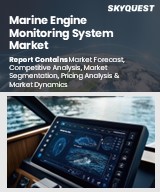
Report ID: SQMIG20E2117
SkyQuest Technology's Marine engine monitoring system market size, share and forecast Report is based on the analysis of market data and Industry trends impacting the global Marine Engine Monitoring System Market and the revenue of top companies operating in it. Market Size Data and Statistics are based on the comprehensive research by our Team of Analysts and Industry experts.
Global Marine Engine Monitoring System Market size was valued at USD 5.2 billion in 2023 and is poised to grow from USD 5.56 billion in 2024 to USD 9.48 billion by 2032, growing at a CAGR of 6.9% during the forecast period (2025-2032).
The growing stringency of international environmental regulations, such as the International Maritime Organization's (IMO) 2020 sulfur emission cap and the push toward decarbonization, is compelling maritime operators to adopt greener practices. Marine engine monitoring systems allow real-time tracking of critical engine parameters like fuel consumption, exhaust composition, and engine load. Through analysis of this information, operators can optimize combustion efficiency, minimize fuel consumption, and constrain greenhouse gas emissions. This not only guarantees environmental compliance but also saves on costs. With sustainability emerging as a competitive edge for shipping companies, the demand for such smart monitoring solutions is heating up globally.
The increasing digitization of maritime operations is giving rise to smart ships—vessels equipped with interconnected systems for automation, data analysis, and remote diagnostics. Central to this transformation are marine engine monitoring systems, which serve as vital tools for managing engine health, forecasting failures, and improving decision-making. These systems gather and send real-time information to onboard and onshore platforms, facilitating proactive maintenance, minimizing downtime, and improving fleet management. With shipowners and operators making investments in smart technologies to improve efficiency, safety, and profitability, engine monitoring systems are increasingly becoming a must-have, pushing their widespread adoption across commercial, naval, and offshore support vessels.
What are Some Examples of Companies Using AI for Marine Engine Fault Detection?
The implementation of Artificial Intelligence (AI) is radically revolutionizing the global marine engine monitoring system market with predictive maintenance and improved operational efficiency. AI-based algorithms process large volumes of real-time data from engine sensors to identify anomalies and anticipate likely failures before they happen. Such proactive measures minimize unexpected downtime, cut costs on maintenance, and prolong the life of engine parts. For example, organizations such as Intangles have created AI-based platforms that generate digital twins of ship engines, enabling precise health checks and timely fault detection. The IConIC system of STS Defence is another example using machine learning technology to track the health of an engine and generate early warnings on probable faults.
In 2024, ABB upgraded marine engine monitoring by adding artificial intelligence to its ABB Ability™ platform. This upgrade provides real-time diagnostics and predictive maintenance by monitoring data from shipboard systems to identify anomalies before they cause failures. The AI system becomes more knowledgeable with historical data and expert feedback, enhancing reliability and minimizing downtime.
REQUEST FOR SAMPLE
Global Marine Engine Monitoring System Market size was valued at USD 4.46 Billion in 2023 poised to grow from USD 4.77 Billion in 2024 to USD 8.12 Billion by 2032, growing at a CAGR of 6.88% in the forecast period (2025-2032).
The global marine engine monitoring system market outlook is extremely competitive, with players emphasizing technological advancements and strategic alliances. Some of the prominent players are Wärtsilä, ABB, Rolls-Royce, Kongsberg Gruppen, and MAN Energy Solutions. Wärtsilä emphasizes digital solutions integration for predictive maintenance, while ABB is stressing AI and IoT integration for real-time monitoring. Rolls-Royce is developing smart ship technologies, using its experience in automation and digital solutions to enhance vessel performance and environmental compliance. 'Wärtsilä (Finland)', 'ABB (Switzerland)', 'Rolls-Royce (United Kingdom)', 'MAN Energy Solutions (Germany)', 'Kongsberg Gruppen (Norway)', 'Caterpillar (USA)', 'Honeywell International (USA)', 'Siemens (Germany)', 'MTU Friedrichshafen (Germany)', 'Emerson Electric (USA)', 'Yokogawa Electric Corporation (Japan)', 'GE Marine Solutions (USA)', 'Navisens (USA)', 'FleetMon (Germany)', 'VesselsValue (United Kingdom)'
The increasing implementation of strict environmental regulations, such as IMO 2020, is driving the demand in global marine engine monitoring system market growth. These rules require less sulfur emissions and fuel consumption, which have brought about the utilization of advanced monitoring technologies to avoid non-compliance, lower emissions, and increased sustainability in the shipping industry.
Integration of IoT and AI for Predictive Maintenance: The integration of IoT and AI technologies in global marine engine monitoring system market trends is enhancing predictive maintenance, reducing downtime, and improving operational efficiency. Real-time data collection, combined with AI-driven analytics, allows for early detection of issues, resulting in cost savings and optimized engine performance.
How does North America's Focus on Maritime Safety Contribute to the Demand for Monitoring Systems?
Want to customize this report? This report can be personalized according to your needs. Our analysts and industry experts will work directly with you to understand your requirements and provide you with customized data in a short amount of time. We offer $1000 worth of FREE customization at the time of purchase.
Feedback From Our Clients

Report ID: SQMIG20E2117
sales@skyquestt.com
USA +1 351-333-4748